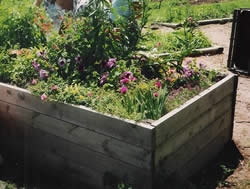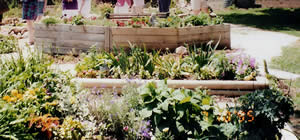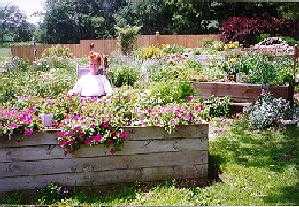Handicap Accessible Gardening
By Josh Spece - 1998
 Many people enjoy gardening as a hobby, or even as a profession. When most people think of gardening, they usually think of someone down on their hands and knees on the ground. This doesn't have to be the case, though. People who have a disability can enjoy gardening just as much as everyone else. Raised gardens can bring the plants up to the people. There are a few things that need to be considered when making a handicap accessible garden.
Many people enjoy gardening as a hobby, or even as a profession. When most people think of gardening, they usually think of someone down on their hands and knees on the ground. This doesn't have to be the case, though. People who have a disability can enjoy gardening just as much as everyone else. Raised gardens can bring the plants up to the people. There are a few things that need to be considered when making a handicap accessible garden.
The first thing to consider, is the construction of the raised garden. It should be a comfortable height to work at. Twenty-eight to thirty inches high is usually good. Second, it should not be too wide. If it is too wide, it will be hard to reach the center of the garden. Generally, it should be no more than two feet to the center, so a bed accessible from all sides could be about four feet across. Length doesn't really matter. It can be as long or as short as you like. The garden can be built with pressure treated two by eight's with four by four posts in each corner. An easy alternative to building a raised bed is to use large pots. You can grow anything in pots, even cucumbers and tomatoes! An advantage to using pots is that they are portable, and can be easily moved. Once the raised bed is built it should be filled with good top soil or compost.
 Next, you need to decide what type of paths to have between and around the raised beds. It can be left as grass, but it may be hard to maneuver a lawnmower down narrow paths. It can also be made of wood chips or mulch. A four to six inch layer will keep the weeds down, but it needs to be replaced every year or two. Wood chips may also be hard for wheelchairs to run on. Another option is pea gravel. This will also keep weeds down, but doesn't have to be replaced as often a wood chips. Once the gravel is compacted, wheelchairs should have no problem getting around on it. A more permanent alternative is a brick or stone patio built around the raised beds. This keeps weeds down, doesn't need to be replaced, and wheelchairs can easily get around on it. A disadvantage to this is that it is more labor intensive and expensive to install.
Next, you need to decide what type of paths to have between and around the raised beds. It can be left as grass, but it may be hard to maneuver a lawnmower down narrow paths. It can also be made of wood chips or mulch. A four to six inch layer will keep the weeds down, but it needs to be replaced every year or two. Wood chips may also be hard for wheelchairs to run on. Another option is pea gravel. This will also keep weeds down, but doesn't have to be replaced as often a wood chips. Once the gravel is compacted, wheelchairs should have no problem getting around on it. A more permanent alternative is a brick or stone patio built around the raised beds. This keeps weeds down, doesn't need to be replaced, and wheelchairs can easily get around on it. A disadvantage to this is that it is more labor intensive and expensive to install.

Once you have the raised garden built and easily accessible, you need to decide what to put in the garden. A good, foolproof choice is annuals. Annuals provide instant color and come in many shapes and sizes in a wide range of colors. Some good choices are petunias, marigolds, snap dragons, pansies, impatients (if you have shade), and annual salvia. Put the tall plants in the center or back of the bed, and work your way down to the shortest plants in the front. Plants that drape over the side of the bed, such as lobelia and petunias, are good for the edge. Hardy perennials can also be grown in raised beds. Some good choices are black-eyed-susans, ornamental grasses, hostas (if you have shade), daisies, dwarf iris, and creeping dianthus for the edges. It will take the perennials a year or two to get established, but after that they require very little care, and don't need to be replaced every year like annuals.
When your garden is planted, it will require very little care. When it is dry, or very hot out, give it a good soaking in the morning or evening, never during the hottest part of the day. About once a month it is a good idea to fertilize your garden so it will keep growing strong and provide lots of flowers and vegetables. Once in a while it is a good idea to dead-head your flowers. This means to take off the old, dead flowers so the plants will continue to make new ones. That's about all there is to maintaining your raised garden.

This is my raised garden with me in the background.
Main Page Hosta Mania! The Orchid Window Water Gardens Garden Tour
 Many people enjoy gardening as a hobby, or even as a profession. When most people think of gardening, they usually think of someone down on their hands and knees on the ground. This doesn't have to be the case, though. People who have a disability can enjoy gardening just as much as everyone else. Raised gardens can bring the plants up to the people. There are a few things that need to be considered when making a handicap accessible garden.
Many people enjoy gardening as a hobby, or even as a profession. When most people think of gardening, they usually think of someone down on their hands and knees on the ground. This doesn't have to be the case, though. People who have a disability can enjoy gardening just as much as everyone else. Raised gardens can bring the plants up to the people. There are a few things that need to be considered when making a handicap accessible garden.


